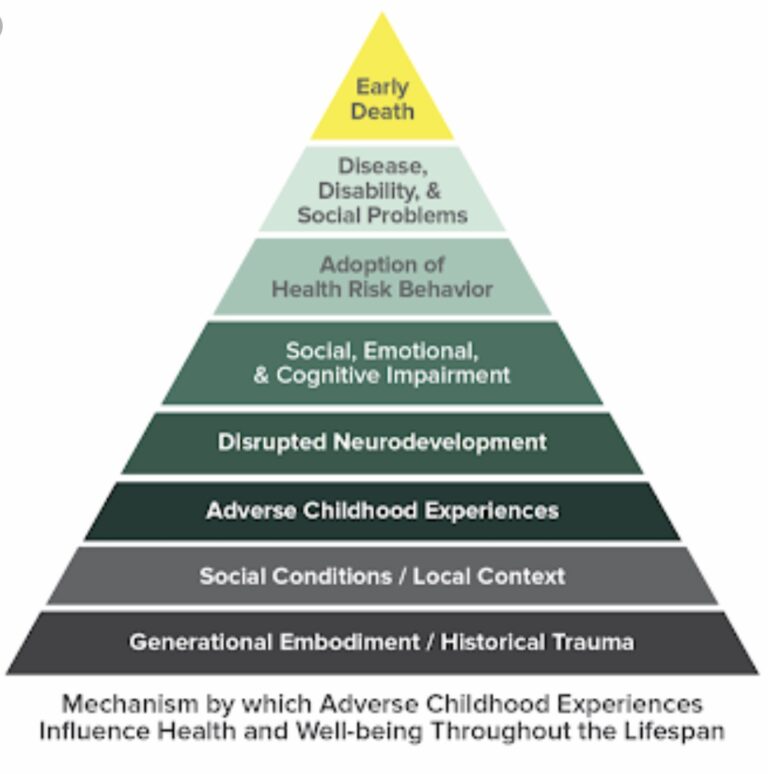
I have forgotten how many times I moved home as a child. Years of therapy haven’t helped me and nothing anyone says will ever change my trauma of being abandoned as a baby. Everyday of my life I wonder how different my life would be if I wasn’t born a girl.
A few years ago when I was studying counselling in the US, I had to fill out an Adverse Childhood Experiences questionnaire. They wanted to test my mental health before I could start helping others with their mental health issues. My ACE score was a shocking 9.5
There are 10 types of childhood trauma in the ACE Study. Five are personal – physical abuse, verbal abuse, sexual abuse, physical neglect and emotional neglect. Five are related to other family members – alcoholic parent, domestic violence, family member with mental illness, divorced parents, abandonment. Each type of trauma counts as one. Other childhood trauma like racism, bullying, death of a parent, homelessness and surviving and recovering from a severe accident are also tabulated in your score.
If you have an ACE score of 4 your chances of chronic pulmonary lung disease increases 390%, hepatitis 240%, depression 460%, attempted suicide 1,220%. I have an ACE score of 9.5. This explains my attempted suicides, ongoing battle with depression, unmanageable asthma, migraines, stage 4 endometriosis, adenomyosis, several incurable psychosomatic diseases, poor immune system, and flu 20 days a month.
There is a direct connection between childhood trauma and chronic diseases people develop as adults, as well as social and emotional problems. More severe the trauma, more severe the chronic diseases like heart disease, cancers, diabetes, violence, abuse and suicide.
Everything you have experienced as a child has an impact on your values, your attachment to others, your moral compass, ability to trust people and most importantly, sense of self worth. Individuals with a high ACE score die about twenty years younger than their counterparts. Relationships are challenging. I have failed in all my relationships. I’m afraid to fall in love, I imagine all that could go wrong in a relationship and tell myself it’s better I’m not in one. The most important relationship is the one with myself and I have failed in that too.
I don’t love myself, I have poor self confidence and I’m a high school dropout. Winning beauty pageants did nothing for my self esteem because I still feel ugly and unwanted. Life is as beautiful or as terrible as you make it. I try to focus on the amazing gifts, opportunities and beauty in my life. My life purpose is to touch lives. In my darkest hour I think of how I can help uplift another’s spirits.
Research on kids’ brains found that toxic stress damages the structure and function of a child’s developing brain. Stressed children go into flight, fright or freeze mode. They learn less, can’t trust adults and don’t have healthy relationships with peers. They tend to be loners who seek comfort in binge eating , alcohol, nicotine, addictive drugs, high risk sports. Severe chronic stress causes inflammation which leads to diseases.
Epigenetics says we are born with a set of genes that can be turned on and off depending on our environment. Toxic stress is passed down from generation to generation and that is the reason children from broken homes almost always have broken marriages. It’s always a cycle.
Individuals with a high ACE score respond poorly to stressful situations, sometimes even 30 years after a traumatic experience. This is because of gene methylation, in which small chemical markers, or methyl groups adhere to the genes involved in regulating the stress response. When the function of these genes are altered, then stress snowballs into autoimmune diseases and depression.
Scientists have found that when the developing brain is chronically stressed, it releases a hormone that shrinks the size of the hippocampus, an area of the brain which processes emotion and memory and managing stress. Higher an individual’s ACE Score, less gray matter they have in the prefrontal cortex, amygdala and other vital areas of the brain. This is the reason traumatised children are often dropouts.
When a child faces unpredictable and chronic stress of Adverse Childhood Experiences, microglial cells release neurochemicals that cause neuroinflammation, that changes the brain for life. They develop mood disorders and have poor decision-making skills
Early trauma makes children emotionally older than their peers. ACE may prematurely age children on a cellular level as well. Adults with early trauma have eroded telomeres – protective caps at the ends of DNA strands, to keep genome healthy and intact. As our telomeres erode, we’re more likely to develop disease, and our cells age faster.
Inside each of our brains, there is a network of neurocircuitry. It unites areas of the brain associated with memory and thought integration. It helps us make decisions and react appropriately to external stimuli from our environment. Children who face early adversity have poor neurocircuitry for the rest of their lives.
There is a pathway between the brain and immune system via lymphatic vessels. The lymphatic system carries lymph—a liquid that helps you eliminate toxins, and moves immune cells from one part of the body to another. For a child who’s experienced adversity, the inflammatory chemicals that flood a child’s body when she’s chronically stressed massively impact immune system.
Chronic childhood adversity weakens neural connections between prefrontal cortex and hippocampus. Girls have weaker connections between the prefrontal cortex and the amygdala. The prefrontal-cortex-amygdala relationship determines your EQ. Poor brain connections = poor mental health.
Physical wounds and bruises heal and so can the brain. Human brain has an amazing ability to reorganise itself, despite any level of trauma, by forming new connections between brain cells. It can rewire itself and build new pathways to change the damage that’s been done. Neuroplasticity or brain plasticity is the brain’s ability to change throughout life.
The brain protects itself by periods of blackouts or non memories. There are periods of my life where I remember nothing, it’s virtually a blank. This is common for children with a traumatic childhood. The brain blocks painful memories, it’s a survival mechanism.
Your environment and activities play a significant role in plasticity. Neuroplasticity occurs in your brain at the beginning of your life, in case of brain injury and during adulthood when you learn something new.
Research shows that the brain never stops changing through learning. Plasticity is the capacity of the brain to change with learning. New connections form between neurons when you learn something new and the internal structure of existing synapses change.
When you become an expert in a specific domain, corresponding area in your brain that deals with this expertise will grow. Learning any new skill or information showed learning-induced brain changes in the parietal cortex region and posterior hippocampus
Plasticity is found in the brains of bilinguals. The left inferior parietal cortex is larger in bilingual brains than in monolingual brains. Learning a new language causes functional changes in the brain.
Neuroplasticity also occurs in musicians brains as compared to non-musicians. Grey matter was highest in professional musicians, intermediate in amateur musicians, and lowest in non-musicians.
When there is a brain injury any activity associated with that area of the brain shifts to another area. If you have a stroke, one area of your brain is damaged and you lose corresponding motor functions. The brain areas killed in the stroke transfer their functions to healthy regions – that’s how you regain motor functions after a brain injury.
The brain compensates for damage by reorganizing and forming new connections between intact neurons. In order to reconnect neurons need to be stimulated through activity. That’s why rehabilitation is vital after any injury. Neurons can grow at any age.

The face of a woman with an ACE score of 9.5
With an ACE score of 9.5 I should have been a drug addict or alcoholic, involved in petty crimes, had a teenage pregnancy or multiple sexual partners, abusive relationships, a dropout with no steady job, mentally ill and overdosed on drugs or committed suicide by now.
Neuroplasticity of my brain has saved me. Working with animals from a young age, learning 10 languages, playing 2 musical instruments, competing in sports – swimming and equestrian. Travelling across the world and learning new skill sets because I dabbled in so many different jobs. Adapting to new situations, cultures and people have rewired my brain.
When I reminisce about my incredible journey, I have no idea how I got this far. People presume I was born with everything but the fact is I started with nothing and then worked my way to perfection. I clawed my way up, inch by inch. I built my castle with stones thrown at me.